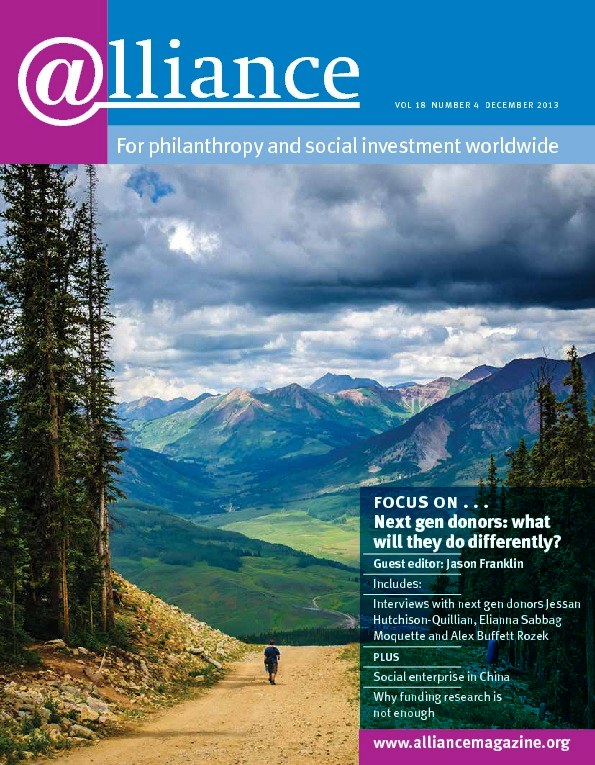With a 20-year history of grassroots grantmaking, Global Greengrants Fund has learned that young people have a big-picture understanding of issues facing their communities but frequently lack access to funding and the capacity and confidence to secure the limited resources available. To help overcome this, Greengrants has set up the Next Generation Climate Board, comprising five leaders from Africa, Asia, Latin America and the Middle East, all in their twenties, to develop a grantmaking programme focused on youth-driven, grassroots climate action and policy.
 Young people across the world have created community groups and built national, regional and global networks. This work has led to a powerful constituency of Youth Non-Governmental Organizations (YOUNGO). This has been active in the global negotiations of the UN Framework Convention on Climate Change and engaged with the Secretariat, state delegations and other stakeholders to urge world leaders to decisively combat climate change.
Young people across the world have created community groups and built national, regional and global networks. This work has led to a powerful constituency of Youth Non-Governmental Organizations (YOUNGO). This has been active in the global negotiations of the UN Framework Convention on Climate Change and engaged with the Secretariat, state delegations and other stakeholders to urge world leaders to decisively combat climate change.
This global influence is rooted in grassroots organizations that coordinate between countries and come together for international days of climate action, such as those organized by 350.org, and in networks, such as the African Youth Initiative on Climate Change. With small amounts of funding, these groups can accomplish impressive things. An example is the Njombe Youth Group in the southern highlands of Tanzania, a region where increased temperature and rain shortfalls have crippled agricultural livelihoods. Through networking and with the help of a small grant, these young people have gained the skills and confidence to engage in dialogue with local leaders and influence local policy on climate change mitigation and deforestation.
A new generation of grantmakers
Global Greengrants Fund is built on a model that puts local environmental leaders and activists in charge of grantmaking decisions. Our grants are small – most are less than $5,000 – and they reach local grassroots organizations in more than 90 countries. To operate at this scale, we rely on a global network of volunteer advisers to develop grantmaking strategies in their regions. They identify prospective grantees, make decisions about which groups and activities to support, mentor and support the groups that receive funding, and help us understand what happened as a result of our funding.
A couple of years ago, when we thought about how best to expand our climate change grantmaking to support the global youth climate movement, we knew that we wanted the grantmaking to be led by young people who were insiders in that movement and who could connect us with some of the most exciting work happening around the world. So we put together a Next Generation Climate Board of young environmental activist leaders. Although most international grantmaking to youth groups is directed by professional philanthropists, we feel that leaders from within youth movements can make the most strategic decisions about how to distribute resources for youth-led activity. We also believe there is great value for young activists in gaining experience as grantmakers and understanding the role that financial resources play in effecting social change. As their careers evolve they will carry forwards lessons on how to support grassroots action.
Grantmaking priorities
Advisers on the Next Generation Climate Board have prioritized grantmaking to youth-led groups that are underfunded or have limited access to funding but are doing meaningful work. We have set out to identify groups that would truly benefit, create an impact and grow from the small grants we give out. An example is a grant to the Iraqi chapter of the Arab Youth Climate Movement, which has successfully advocated for a ban on leaded gasoline in Iraq. In a country emerging from war, funding for such youth activities is immensely hard to find.
Our strategy also recognizes that the diversity of interests and activities of today’s young people is a key asset in achieving social change. Nearly all of our youth grantees reach beyond simply raising the alarm about climate change and reframe the issue, connecting it to other societal issues such as health, disaster prevention, waste management, job creation, local politics and cultural preservation. Grantees often incorporate art, music, film and multimedia productions into their grant proposals – a fusion of social change with shaping cultural norms.
 One example is a grant to Kitulectivo, a new youth group in Ecuador, so that its members could cycle over 3,500 kilometres through Ecuador’s coastal, Andean and Amazonian regions to draw attention to the efforts young people are taking to address climate change and encourage leaders to do more. Another grant funded indigenous young people in the Cordillera region of the Philippines to organize cultural festivals and immersion exchanges bringing urban indigenous youth back to rural communities to meet with elders. The aim was to build intergenerational awareness of the impact of climate change on indigenous culture and the solutions offered by traditional knowledge. Pictured: Kitulectivo members cycling through Ecuador to encourage leaders to do more about climate change. Credit: Ximena Paltán Obregón, Climacleando 2013
One example is a grant to Kitulectivo, a new youth group in Ecuador, so that its members could cycle over 3,500 kilometres through Ecuador’s coastal, Andean and Amazonian regions to draw attention to the efforts young people are taking to address climate change and encourage leaders to do more. Another grant funded indigenous young people in the Cordillera region of the Philippines to organize cultural festivals and immersion exchanges bringing urban indigenous youth back to rural communities to meet with elders. The aim was to build intergenerational awareness of the impact of climate change on indigenous culture and the solutions offered by traditional knowledge. Pictured: Kitulectivo members cycling through Ecuador to encourage leaders to do more about climate change. Credit: Ximena Paltán Obregón, Climacleando 2013
Integrated, creative projects like these ground the challenge of climate change, fit it squarely into the daily concerns of young people, and mobilize them to more actively engage with a problem that would otherwise seem remote and unassailable at the local level.
While social media use is geographically constrained by electricity and internet connectivity, youth around the world have been especially quick to adopt tools such as Twitter, YouTube, Facebook, email and blogs to reach other young people. Many of our grants have helped young people document and share stories and images related to climate change – and to use those to compel politicians to address climate change in their region. To this end, a small grant enabled the United Arab Emirates chapter of the Arab Youth Climate Movement to launch a social media competition for young people to propose creative climate change solutions.
What difference has the Next Generation Climate Board made?
Youth advisers have helped Global Greengrants Fund better understand where youth-led organizations are coming from, the challenges they face, and where we need to make changes to traditional grantmaking models and expectations. One challenge we grapple with is that most young people can articulate their goals better verbally than in a written proposal. Advisers find themselves following up with applicants by telephone or email in order to fully understand the ideas or concepts they are proposing.
We also find that many youth-led groups, because of a limited track record, focus their proposals on the activities to be carried out but have trouble envisaging the outcomes. As social change grantmakers, we want to see our funds engaging people in advocacy and building capacity, but this can be hard to extrapolate from proposals that centre on tree planting or eco-briquette making. We make sure the groups incorporate strong advocacy and mobilization objectives even when projects emphasize livelihood and income activities. We also know that youth groups experience regular turnover in personnel as leaders move on, so we consider carefully how groups ensure continuity in their mission and programmes.
Young people’s organizations are also at a disadvantage when it comes to joining networks. They are often not taken seriously and must work hard to earn the recognition and respect of more established groups. This was the case for Young Potential Group, a small Kenyan organization in Nairobi’s low-income areas, whose work on climate change stands out in a place where most initiatives focus on health, education and livelihood projects. However, their reputation is unknown to established environmental groups and we have had to go beyond our funding role to help them make some of these connections.
A replicable experiment
We are eager to share our experience of involving next generation activists in grantmaking because we want to encourage other funders to think about how they can incorporate advice from young people in their work. A main reason for trying this is to bring in new perspective to grantmaking. This difference in perspective stems not only from the changes in outlook we experience at different stages in life but also from the neuro-biological changes that occur in our mid to late twenties which, according to research, change the way we calculate risk. While youthful decision-making may be considered too risky for car insurers and public health campaigns, it could be the secret for great innovation in social change philanthropy. We also believe that involving young people in philanthropy increases access to funding for other young people because they are better able to see the needs, challenges and potential of their peers.
From the original Earth Day movement in the United States to the more recent emergence of the grassroots environmental movement in China, led by more than 1,300 student organizations, young people have demonstrated how much they can change society with remarkably little in the way of outside resources. Even modest investment in their ideas, organization and leadership development can yield great returns.
Winnie Asiti is an adviser on GGF’s Next Generation Climate Board and to the African Youth Initiative on Climate Change. Email w_asiti@yahoo.com
Peter Kostishack is director of programs at Global Greengrants Fund. Email peter@greengrants.org





Comments (0)